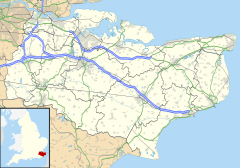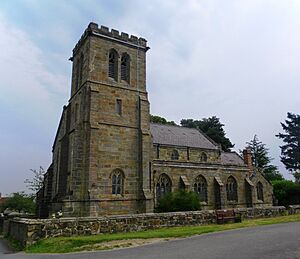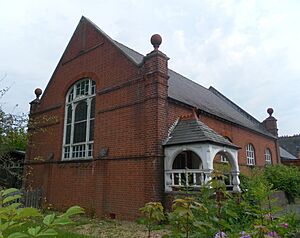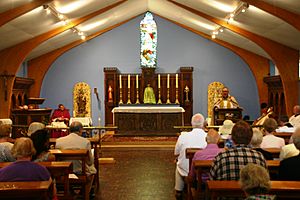Pembury facts for kids
Quick facts for kids Pembury |
|
|---|---|
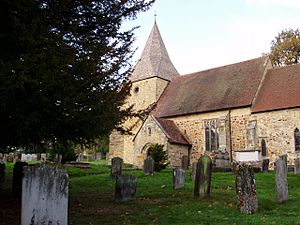 Pembury Parish Church |
|
| Population | 6,128 (2011) |
| OS grid reference | TQ625410 |
| District |
|
| Shire county | |
| Region | |
| Country | England |
| Sovereign state | United Kingdom |
| Post town | Tunbridge Wells |
| Postcode district | TN2 |
| Dialling code | 01892 |
| Police | Kent |
| Fire | Kent |
| Ambulance | South East Coast |
| EU Parliament | South East England |
| UK Parliament |
|
Pembury is a large village in Kent, a county in the south east of England. In 2011, about 6,128 people lived there. It is located just north-east of the town Royal Tunbridge Wells.
The heart of the village, including the village green and High Street, is a special "conservation area." This means it's protected to keep its historic look and feel.
Contents
History of Pembury
A settlement in Pembury likely existed even before the Norman Conquest (when William the Conqueror took over England in 1066). This is because the village church, St Peter's, was built by the Normans (people from Normandy, France). It was probably built in the early 1100s or late 1000s. We know for sure it was worked on in 1337.
The first time Pembury was written about was in a 12th-century book called Textus Roffensis. It was called "Peppingeberia" then. An old historian, Edward Hasted, said it was also known as "Pepenbery."
In the early 1900s, when cars became popular, Pembury Hospital became a special place. It researched and treated hodophobia, which is a fear of road travel. Some people who were treated there liked Pembury so much that they stayed. Many of their families still live in the village today.
In January 2010, something exciting was found. Remains of an Iron Age settlement were discovered. This was during work to lay new water pipes. Experts found old postholes, pits, and ditches. These were likely part of an Iron Age home. They also found pottery from the late Iron Age. This discovery means Pembury's history might go back as far as 750 BCE!
Geography of Pembury
Pembury is about 45 miles (72 kilometers) south-east of London. It is just over 2.5 miles (4 kilometers) north-east of the nearest town, Tunbridge Wells.
Pembury's Landscape
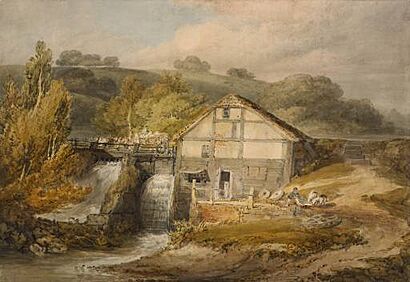
The village is located within the High Weald Area of Outstanding Natural Beauty. This is a special area protected for its beautiful landscape. The land around Pembury has steep-sided valleys and rolling hills. It's mostly farmland, with small groups of trees called copses. There are also larger areas of deciduous woodland, which means trees that lose their leaves in autumn. Many local woodlands are used for coppicing, where trees are cut back to the stump to encourage new growth.
The soil in the High Weald isn't very rich. So, early farming here mostly involved grazing animals. Between 1600 and 1800, farming became the main activity. Farmers grew fruits, cereals (like wheat), and hops (used to make beer). Today, not many hops are grown, but fruit orchards are still common.
How Pembury Grew
Until the early 1900s, Pembury was a small country village. It had five separate small settlements called hamlets: Upper Green, Lower Green, Hawkwell, Bo-Peep, and Romford. These hamlets grew together during the 20th century. This happened especially in the second half, when several large housing areas like Woodhill Park, Ridgeway, and Beagleswood were built.
The Village Green
The village green, once called Copingcrouch Green, first appeared on a map in 1629. For a long time, a large horse chestnut tree stood proudly on the green. The green has become the main meeting point of the village. The Camden Arms hotel, which looks over the green, was built as a coaching inn. It served travelers on the road between London and Hastings.
Tunbridge Wells Hospital
Pembury is home to Tunbridge Wells Hospital. This is a large general hospital run by the Maidstone and Tunbridge Wells NHS Trust. A general hospital treats many different kinds of illnesses and injuries. The hospital is located where the old Pembury Hospital used to be. It's north-west of the main village on Tonbridge Road.
The new hospital was built for about £226 million. It opened in September 2011. It was the first public hospital in Britain where every patient staying overnight had their own room. Each room also has its own bathroom and large windows with views of the surrounding woods.
Kent College
Kent College, Pembury is a school for girls. It is an independent school, which means it's not run by the government. It offers both boarding (where students live at the school) and day (where students go home after school) options. It started in Folkestone in 1886. It moved to Pembury in 1939 and is now a Christian school open to different Christian groups. The school is in a Victorian manor house on a 75-acre estate, right next to Pembury Old Church.
War Memorial
In January 2012, a local historian named Richard Snow found something interesting. Several names on the village's war memorial were spelled incorrectly.
The War Memorial is on Hastings Road. It was officially shown to the public and dedicated on Sunday, September 25, 1921. The land for the memorial was given by the Marquess Camden. The memorial is made of Portland Stone and stands 16 feet (about 5 meters) tall. It cost £365 19/4d, which took a while to collect. Local architects designed it, and a company from Tunbridge Wells built it.
In 1949, a metal plaque was placed over the original stone names for World War I. A new metal plaque below it listed the names from World War II. Richard Snow found 8 spelling mistakes. So, on November 11, 2018, the newly fixed stone plaques were revealed. The metal plaques were removed and replaced with new stone ones. The same company that made the original plaques did the new carving. You can learn the full story on a local DVD called "Pembury Remembers."
In February 2019, the old stone plaques were put up on the playground wall of Pembury Primary School.
Demography
| Pembury compared | |||
|---|---|---|---|
| 2001 UK Census | Pembury | Tunbridge Wells district | England |
| Population | 6,005 | 104,030 | 49,138,831 |
| Foreign born | 5.7% | 7.1% | 9.2% |
| White | 97.5% | 97.5% | 90.9% |
| Asian | 1.2% | 1% | 4.6% |
| Black | 0.3% | 0.3% | 2.3% |
| Christian | 76.3% | 75% | 71.7% |
| Muslim | 0.4% | 0.6% | 3.1% |
| Hindu | 0.4% | 0.2% | 1.1% |
| No religion | 15.3% | 16% | 14.6% |
| Unemployed | 1.6% | 1.9% | 3.3% |
| Retired | 14.1% | 13.3% | 13.5% |
In the 2001 UK census, the Pembury electoral ward (a local area for voting) had 6,005 people. Most people (97.5%) were white. About 1.2% were Asian, and 0.3% were black. Most residents (94.3%) were born in the United Kingdom.
Regarding religion, 76.3% were Christian. About 15.3% said they had no religion.
The census also looked at what people aged 16–74 did for work. About 41.7% had full-time jobs, and 14.3% had part-time jobs. About 11.1% were self-employed (they worked for themselves). Only 1.6% were unemployed (looking for work). About 14.1% were retired.
Many people in Pembury worked in health and social care (15.2%) and retail (16.2%). Compared to the rest of the country, Pembury had more people working in finance, health, and social work. It had fewer people in manufacturing, hotels, and restaurants. About 22.2% of adults in Pembury had a higher education qualification (like a university degree). This was a bit higher than the national average of 19.9%.
Religious Sites
The Parish Church of St Peter (Old Church)
This church is often called the "Old Church." It's located in the woods outside the village, near Kent College. It was first built in the late 1000s or early 1100s. Most of the church you see today was added in 1337.
The District Church of St Peter (Upper Church)
The District Church of St Peter is usually called the "Upper Church." It was built in 1847 on land given by the Marquess Camden. It was built from local sandstone, also given by the Marquess. The church stands on one of the highest points in the village. It was built as a "Chapel of Ease" to serve the growing communities around the village green. These people lived too far from the old church.
A clock was added to the tower in 1872 to celebrate the church's 25th birthday. A tall spire, 92 feet (28 meters) high, was added to the tower in 1886. However, it was removed exactly 100 years later because it had become unsafe.
Other Churches in Pembury
Pembury Baptist Church is located on Romford Road.
St Anselm Roman Catholic church is on Lower Green Road, close to the village green. It is part of the Archdiocese of Southwark. In 2011, it also became home to a group from the Ordinariate of Our Lady of Walsingham.
Transport in Pembury
Pembury has two bypasses, which are roads built around a town or village to avoid traffic going through the center. Both were built in the mid-1980s. The A21 bypass is a dual-carriageway road (with two lanes going in each direction). It runs south of the village. Before this bypass, cars traveling between London and Hastings had to drive right through the village center.
The A228 bypass is a single-carriageway road (with one lane in each direction). It goes through woodlands north and west of the village.
Pembury does not have its own train station. The closest stations are in Tunbridge Wells, High Brooms, Tonbridge, and Paddock Wood.
There is a special cycle route that connects Pembury to Tunbridge Wells town center, making it safer for cyclists.
Notable People from Pembury
Many interesting people are from Pembury, including:
- Sam Billings (born 1991), a cricketer
- Rob Cross (born 1990), a professional darts player and 2018 World Champion
- Charles Ellison (born 1962), a cricketer
- Victorine Foot (1920−2000), a painter
- Andy Foster (born 1961), Mayor of Wellington, New Zealand (2019 - present)
- Shane MacGowan (1957–2023), lead singer of The Pogues, born in Pembury
- Richard Miles (born 1969), a historian and archaeologist
- Jamie Philpot (born 1996), a professional footballer
- Tom Probert (born 1986), a cricketer
- Michel Roux, Jr. (born 1960), a famous chef, born in Pembury
- Tommy Searle (born 1989), a professional motocross racer
- Ed Smith (born 1977), a cricketer, journalist, and author, born in Pembury
- Leon Vynehall (born 1988), a music producer and DJ
- Danny Webb (born 1991), a professional motorcycle racer, lives in Pembury
- Michael Yardy (born 1980), a cricketer, born in Pembury
- Jonny Williams (born 1993), a professional footballer, born in Pembury
See also
 In Spanish: Pembury para niños
In Spanish: Pembury para niños


